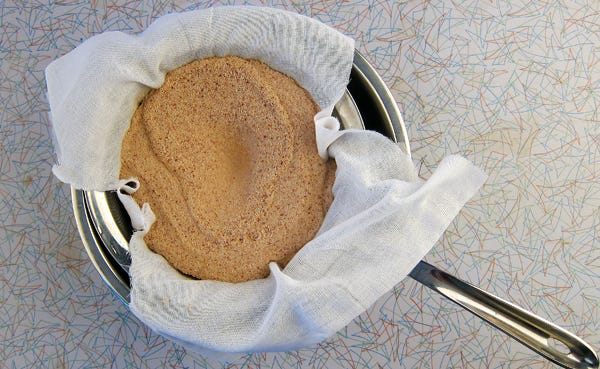
Guest Essay: Ode to a Strainer
My friend Hank Shaw, a Northern California writer, author and blogger at Hunter Angler Gardener Cook, describes himself this way: "I write. I fish. I dig earth, gather things from the wild, raise plants, live for food and hunt anything that tastes good." Doing that requires a few basic tools, one of which he wrote about recently on his new venture with his partner, journalist and photographer Holly Heyser, a collection of wide-ranging essays called To The Bone.
This simple tool makes my food better almost every day.
I get asked about the secret to my cooking all the time. There are a lot of reasons why my food tastes the way it does, some of them learned from long decades of experience. But there’s one you can pick up tomorrow and vastly improve your own performance in the kitchen: a fine-meshed strainer.
Or better yet, several.
Sieving and straining food elevates the end product by removing lumps, debris, impurities or indigestible bits. And if you don’t think this matters, here’s a case study.

Years ago, my co-worker Laura decided she wanted to make soup for her family. I can’t remember if it was based on one of my recipes or not, but regardless, she’s not a hunter so it was store-bought products.
She liked the soup, but her family did not, derisively calling it “debris soup” because in the bottoms of their bowls lurked a witch’s brew of bone bits, clotted blood, stem fragments and other things too horrible to mention. The broth tasted chalky and sour to them.
Turns out Laura never strained her broth. What went into the pot stayed there, and while this is often perfectly fine, it sure isn’t when you want to make a broth that then becomes a soup.
Another case: Years ago, when I learned how to make a proper salsa, and I am talking a smooth Mexican salsa, not pico de gallo, the ladies who taught me made sure I knew to push the blended salsa through a strainer (top photo).
Why? Because if I didn’t, I and everyone else who ate that salsa would pay for it in the morning. Turns out the skins and seeds of chiles are not digestible. (And in fact the seeds of certain chiles need to pass through the digestive tract of animals, notably birds, before they can even germinate!) If you’ve ever had the “ring of fire” in the morning, blame the skins and seeds.
And blame cooks who failed to strain their salsas.
I use my strainers almost every day.
One day I am rendering fat. Straining separates the clean fat from the asiento, the “seat” of fine fatty bits that is so wonderful on a tortilla. That strained fat is purer, and lasts longer because there’s no debris in it to attract mold.
Another day I am making a syrup out of something like chokecherries or prickly pears or gooseberries. If you want the most flavor, you need to initially make these syrups with the whole fruit, pits, seeds and skins and all. But even whizzing it in a fancy Vitamix blender won’t totally remove them from the finished product.
So you need to strain. Otherwise, you get a layer of sediment at the bottom of your syrup, which not only makes it ugly, but makes it taste weird. You don’t want floaters on your pancakes.
Sauces are the same. Running a gravy or a pan sauce through a strainer elevates it, makes it prettier and cleaner-tasting.
Nowhere is this more true than in broths and stocks.
I strain these several times, the last time through a paper towel set inside the strainer. This, plus the fact that I never let a broth boil—boiling will emulsify fat or calcium particles in the liquid, turning the broth cloudy—which results in an almost consommé-like broth without the fancy raft and re-cook.
Even where there’s no liquid involved, I love my strainers.
When I grind chiles for pepper powder I use a strainer. Ditto for when I make acorn flour or masa harina or porcini powder.
You may ask which strainers I prefer, and while I have no brand recommendations, I will tell you that they should be sturdy, because you will forcefully push things through them from time to time. And they should be of different sizes. You can always make do with a larger one, but having a large and a small strainer makes life better; many companies make nesting sets of three.
You also want your strainers to have two handles, long on one side, C-shaped on the other. Why? This allows you to set the strainer over a bowl or pot, so you can do your thing. The ancient, one-handled strainers are irritating.
A cheffy chinois is nice, but not totally needed, nor is the even cheffier tamis, which is a drum sieve. I find them hard to clean, and I’ve never had a tamis that I haven’t blown out the bottom of.
Strainers make everything better. We used them many times a day in the restaurants I worked in, and they are an easy way to improve your own cooking at home.